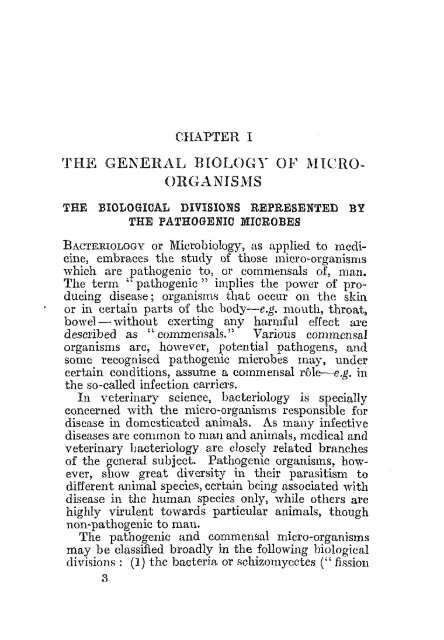AGf~ICULTURAL RESEARCH, PUSA.
AGf~ICULTURAL RESEARCH, PUSA.
AGf~ICULTURAL RESEARCH, PUSA.
Create successful ePaper yourself
Turn your PDF publications into a flip-book with our unique Google optimized e-Paper software.
CHAPTER I<br />
THE GENERAL BIOLOGY OF MICRO<br />
ORGANIS1VIS<br />
THE BIOLOGICAL DIVISIONS REPRESENTED BY<br />
THE PATHOGENIC MICROBES<br />
BACTERIOLOGY or Microbiology, as applied to mcdicine,<br />
embraces the study of those micro-organisms<br />
which are pathogenic to, or commensals of, man.<br />
The term "pathogenic" implies the power of producing<br />
disease; organisms that occm on the skin<br />
or in certain parts of the body-e.g. mouth, throat,<br />
bowel- without exerting any harmful effect are<br />
described as "commensals." Various commensal<br />
organisms are, however, potential pathogens, and<br />
some recognised pathogenic microbes may, under<br />
certain conditions, assume a commensal role------e.g. in<br />
the so-called infection carriers.<br />
In veterinary science, bacteriology is specially<br />
concerned with the micro-organisms responsible for<br />
disease in domesticated animals. As many infective<br />
diseases are common to mall and animals, mcdical and<br />
veterinary bacteriology are closely relatcd branches<br />
of the general subject. Pathogenic organisms, however,<br />
show great diversity in their parasitism to<br />
different animal species, certain being associated with<br />
disease in the human species only, while others are<br />
highly virulent towards particular animals, though<br />
non-pathogenic to man.<br />
The pathogenic and commensal micro-organisms<br />
may be classified broadly in the following biological<br />
divisions: (1) the bacteria or schizomycetes (" fission<br />
3

















